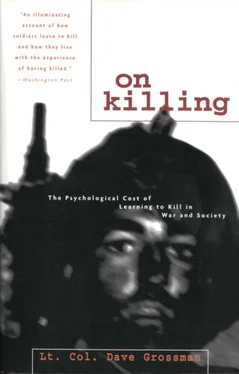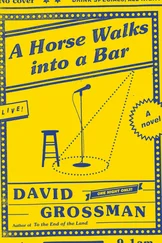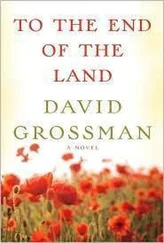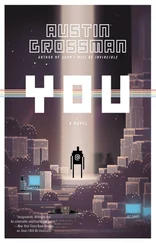Limited chemical treatments have been used in recent years to assist in the recovery process. According to Watson, “the so-called truth drugs have also been used near the front line to ‘abreact’ soldiers who are shell-shocked.” Such drugs have reportedly been used with some success by the Israelis to induce psychiatric casualties to “talk through the circumstances leading to their reaction, an activity which appears to prevent their fears being ‘bottled up’ and so causing some other, long-term syndrome.”
But the use of chemicals in combat may not be quite so benign in the future. Gabriel, a retired intelligence officer and consultant to both the House and Senate Armed Services Committees, provides a chilling note on the future of the treatment and prevention of combat psychiatric casualties. He believes that the armed forces of both the West and the East are searching for a chemical answer to this problem. Gabriel warns that the perfection of a “nondepleting neurotrop” to be given to soldiers prior to battle would result in “armies of sociopaths.”
Gabriel concludes from his research that “one can but marvel at the inventiveness of the human psyche in its efforts to escape its surrounding horror.” Similarly, we must marvel at the inventiveness of modern armies and nations in their efforts to ensure that they get full value from their soldiers. And we cannot help but come away with an image of war as one of the most horrifying and traumatic acts a human being can participate in. War is an environment that will psychologically debilitate 98 percent of all who participate in it for any length of time. And the 2 percent who are not driven insane by war appear to have already been insane — aggressive psychopaths — before coming to the battlefield.
CHAPTER TWO
The Reign of Fear
If I had time and anything like your ability to study war, I think I should concentrate almost entirely on the “actualities of war” — the effects of tiredness, hunger, fear, lack of sleep, weather…. The principles of strategy and tactics, and the logistics of war are really absurdly simple: it is the actualities that make war so complicated and so difficult, and are usually so neglected by historians.
— Field Marshal Lord Wavell, in a letter to Liddell Hart
What goes on in the mind of a soldier in combat? What are the emotional reactions and underlying processes that cause the vast majority of those who survive sustained combat to ultimately slip into insanity?
Let us use a model as a framework for the understanding and study of psychiatric casualty causation, a metaphorical model representing and integrating the factors of fear, exhaustion, guilt and horror, hate, fortitude, and killing. Each of these factors will be examined and then integrated into the overall model to present a detailed understanding of the combat soldier’s psychological and physiological state.
The first of these factors is Fear.
Research and the Reign of Fear
A variety of past investigators came up with an overly simplistic — yet widely accepted — explanation for psychiatric casualties when they declared that the cause of most trauma in war is the fear of death and injury. In 1946 Appel and Beebe held that the key to understanding the psychiatric problems of combat soldiers was the simple fact that the danger of being killed or maimed imposed a strain so great that it caused men to break down. And Watson, a London Times journalist who made a multiyear study of the application of psychology and psychiatry to war, concludes in his book War on the Mind that “combat stress, with its real fear of death, is quite different from other kinds of stress.”
But clinical studies that tried to demonstrate that fear of death and injury are responsible for psychiatric casualties have been consistently unsuccessful. An example of such a study is Mitchell Berkun’s 1958 research into the nature of psychiatric breakdown in combat. Berkun began with a concern for “the role played by fear, that, is by a concern about possible death or injury in the response to adverse environments.” In one of his experiments soldiers on board a military transport aircraft were told that their pilot would soon be forced to crash-land the plane. The men put through the controversial — and by today’s standards unethical — fear-provoking situations in these Human Resources Research Office tests were then given “long psychiatric interviews before and after and again weeks later to see whether there were any hidden effects. None were found.”
The Israeli military psychologist Ben Shalit asked Israeli soldiers immediately after combat what most frightened them. The answer that he expected was “loss of life” or “injury and abandonment in the field.” He was therefore surprised to discover the low emphasis on fear of bodily harm and death, and the great emphasis on “letting others down.”
Shalit conducted a similar survey of Swedish peacekeeping forces who had not had combat experience. In this instance he received the expected answer of “death and injury” as the “most frightening factor in battle”. His conclusion was that combat experience decreases fear of death or injury.
In both the Berkun and Shalit studies we see indications that fear of death and injury is not the primary cause of psychiatric casualties on the battlefield. Indeed, Shalit found that even in the face of a society and culture that tell the soldiers that selfish fear of death and injury should be their primary concern, it is instead the fear of not being able to meet the terrible obligations of combat that weighs most heavily on the minds of combat soldiers.
One of the reasons that fear may have been generally accepted as the major explanation for combat stress is that it has become socially acceptable. How many times have we heard in movies and on television that only fools are not afraid? Such acceptance of fear is a part of modern culture. But we still tend to carefully avoid any examination of what kind of fear — fear of death, injury, failure, and so on.
During World War II the U.S. Army intentionally built a permissive attitude toward fear, and Stouffer’s landmark World War II studies of 1949 show that men who exhibited controlled fear were not generally poorly regarded by their peers. Indeed, during World War II, in a widely distributed pamphlet entitled Army Life, the U.S. Army told its soldiers: “YOU’LL BE SCARED. Sure you’ll be scared. Before you go into battle you’ll be frightened at the uncertainty, at the thought of being killed.” A statistician would call that biasing the sample.
Research in this field has been that of blind men groping at the elephant — one grasps what he thinks is a tree, another finds a wall, and still another discovers a snake. All have a piece of the puzzle, a piece of the truth, but none is completely correct.
There is within us the need to say what is socially acceptable, and like blind men groping at some vast beast, we tend to report that aspect of its anatomy that we already expect to find, and we reject those manifestations with which we feel uncomfortable. The supplied, accepted, comfortable name for this beast is “fear.”
And few people are comfortable when dealing with such powerful alternative explanations as guilt. Fear is a specific yet brief and fleeting emotion that lies within the individual, but guilt is often long term and can belong to the society as a whole. When we are faced with hard questions and the difficult task of introspection, it is very easy to avoid the truth and give the socially acceptable answers that war literature, Hollywood films, and scientific literature tell us we should give.
Fear’s Place in the Soldier’s Dilemma
Читать дальше







